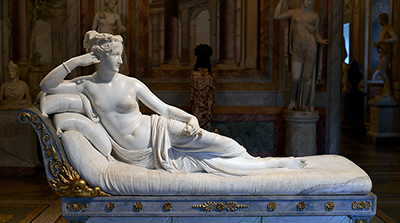Pauline Bonaparte as Venus Victorious (Venus Victrix) refers to a life-size semi-nude neo-Classical portrait sculpture that was designed by Antonio Canova, the Italian sculptor. The sculptor was commissioned by Camillo Borghese, Pauline Bonaparte's husband, and was later executed in the city of Rome from 1805 to 1808.
This was after she got married to the Borghese family's representative. On completion, it was moved to Camillo's residence in Turin, before later being moved to Genoa. It would, later on, arrive at the Galleria Borghese in 1838. The princess who went on to cause quite a stir among her contemporaries chose to dress within the guise of Venus, the goddess who had been triumphant within the Paris Judgement. Her decision to do so was meant to exaggerate her dynastic and social status, as well as her popular magnificence. In this sculpture, Paolina (1780 to 1825) can be seen lying semi-nude on a painted wooden dormouse.
The dormouse is then beautified using gilded insets. She is seen holding an apple with her slim fingers which were credited to Venus as a sign aimed at recognizing her supremacy among all female mysticisms. Compositional guile and antiquated beauty are blended within the naturalistic and almost pictorial rendering of the light cloak used to cover her hips and delicate tissue.
In 1805, Antonio Canova was commissioned by Pauline’s husband to carve the statue when she was only twenty-five years old. By then, she had already made a name for herself as a renowned socialite, who was at the time enjoying her time at the top of social success. A year earlier, Napoleon had made a formal announcement that had seen him become the Emperor of the French. Pauline Bonaparte had, as such, expected to gain the title of Imperial Highness. After being commissioned to carve the sculptor, Canova settled on a theme related to Greek mythology to assist him to create the perfect masterpiece.
He was able to portray Pauline as she held an apple in her left hand. It was an image meant to evoke the victory of Venus in her contest of the three most attractive goddess of Olympus. It was a contest that pitted Juno or Hera, Minerva or Athena, and Venus or Aphrodite. The prize for this particular contest was a golden apple that had been addressed "To the Fairest." Initially, the sculpture was meant to depict Pauline Bonaparte as a fully clothed Diana, the chaste goddess. However, Pauline preferred being depicted as Venus and went on to insist on the same. She had developed a reputation of being promiscuous and, therefore, reveled in the controversy that came with her choosing to pose naked.




